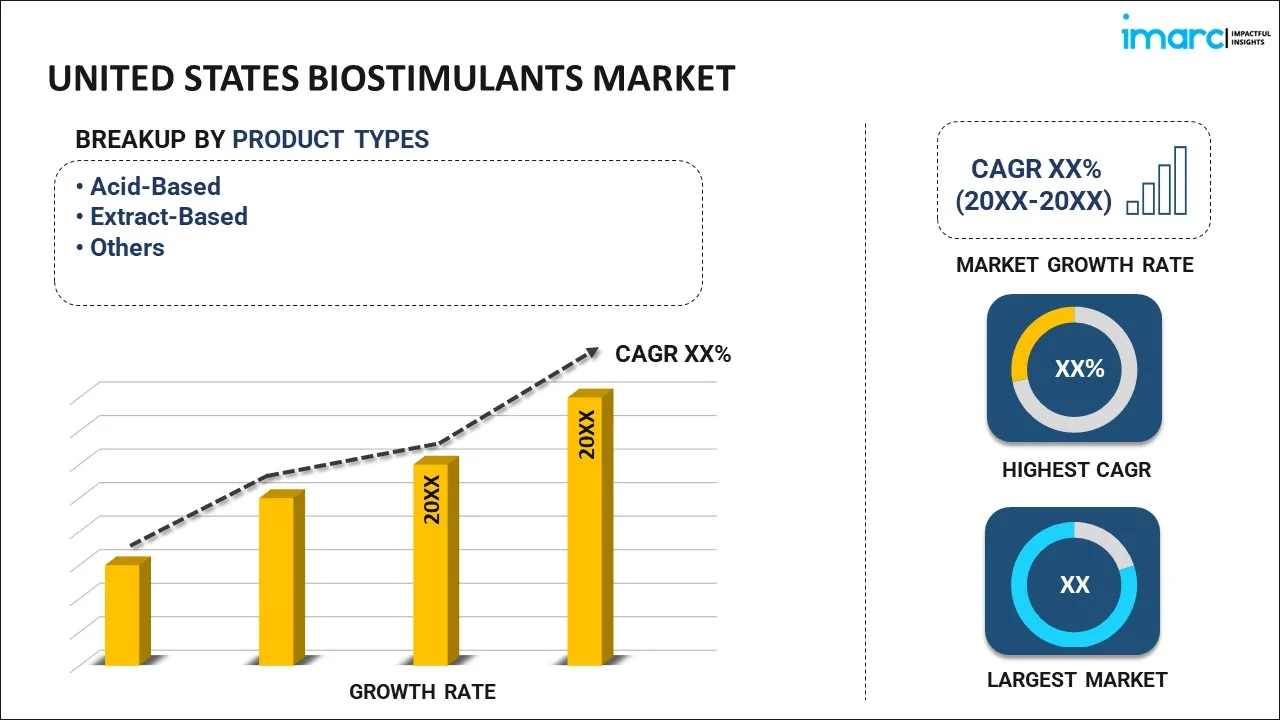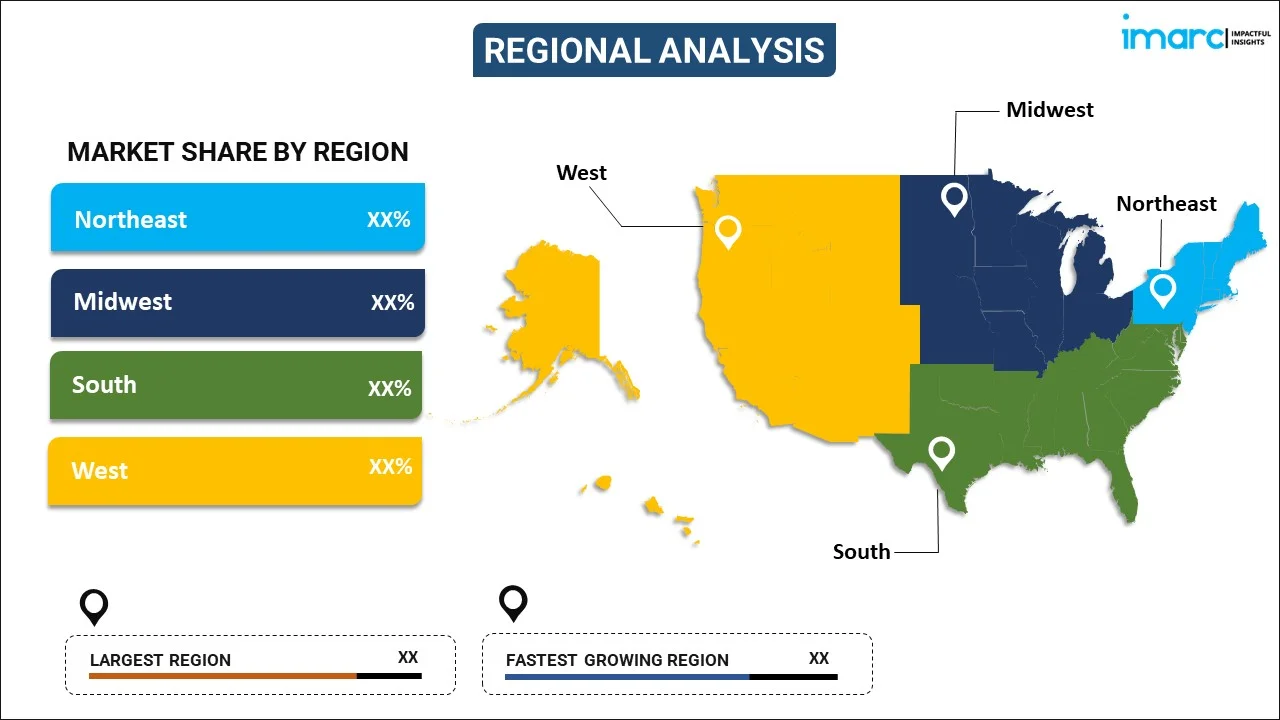
United States Biostimulants Market Report by Product Type (Acid-Based, Extract-Based, and Others), Crop Type (Cereals and Grains, Fruits and Vegetables, Turf and Ornamentals, Oilseeds and Pulses, and Others), Form (Dry, Liquid), Origin (Natural, Synthetic), Distribution Channel (Direct, Indirect), Application (Foliar Treatment, Soil Treatment, Seed Treatment), End User (Farmers, Research Organizations, and Others), and Region 2024-2032
Market Overview:
United States biostimulants market size is projected to exhibit a growth rate (CAGR) of 13.97% during 2024-2032. The growing concerns among farmers about climate change, soil health, and the environmental impact of conventional chemicals, shifting preferences of individuals for organic and sustainably produced food, and the integration of precision farming tools represent some of the key factors driving the market.
|
Report Attribute
|
Key Statistics
|
|---|---|
|
Base Year
|
2023 |
|
Forecast Years
|
2024-2032
|
|
Historical Years
|
2018-2023
|
| Market Growth Rate (2024-2032) | 13.97% |
Biostimulants are usually derived from organic sources, such as seaweed extracts, humic acids, beneficial microorganisms, or plant extracts. They contain a wide range of bioactive compounds, including amino acids, vitamins, enzymes, and phytohormones, which can vary depending on the source. They are generally non-toxic to plants, humans, and living organisms, making them environment friendly. They can improve the absorption of essential nutrients by plant roots, leading to better overall nutrient use efficiency. They help plants withstand various environmental stressors, such as drought, heat, or disease, by enhancing their natural defense mechanisms. They facilitate higher crop yields, improved fruit quality, and extended shelf life. They are widely used in conventional and organic farming practices to improve crop production and quality. They can be applied to various crops, including fruits, vegetables, grains, and ornamental plants. Moreover, as they enhance turfgrass health and appearance, biostimulants are utilized in the maintenance of sports fields, golf courses, and lawns.
United States Biostimulants Market Trends:
The growing concerns among farmers about climate change, soil health, and the environmental impact of conventional chemicals are driving the demand for alternatives to conventional chemical inputs in the United States. Along with this, shifting preferences towards organic and sustainably produced food are offering a favorable market outlook. Apart from this, the United States Environmental Protection Agency (EPA) is undertaking numerous steps to define and regulate biostimulants, providing clear guidelines for their use. Furthermore, continuous advancements in biotechnology are leading to the development of more effective and targeted biostimulant products. Researchers are using cutting-edge technologies to identify and extract beneficial compounds from natural sources. These innovations are improving the efficacy of biostimulants, making them a viable option for modern farming. Moreover, the growing awareness and education about the benefits of biostimulants within the agricultural community is influencing the market positively. Farmers and agronomists are attending workshops, seminars, and webinars to learn about the science and practical applications of biostimulants. In line with this, the integration of digital technologies, such as data analytics, remote sensing, and precision farming tools, is extending the applications of biostimulants. Farmers are using data-driven insights to make informed decisions about applying biostimulants for maximum impact. In addition, the rising collaborations between manufacturers, agricultural universities, and research institutions are strengthening the growth of the market. These partnerships foster innovation and the development of new biostimulant products, attracting a wider consumer base. Besides this, the growing trend towards precision agriculture is leading to the development of customized biostimulant solutions. Farmers can now tailor biostimulant applications to suit specific crop needs and soil conditions, optimizing their effectiveness.
United States Biostimulants Market Segmentation:
IMARC Group provides an analysis of the key trends in each segment of the market, along with forecasts at the country level for 2024-2032. Our report has categorized the market based on product type, crop type, form, origin, distribution channel, application, and end user.
Product Type Insights:

- Acid-Based
- Humic Acid
- Fulvic Acid
- Amino Acid
- Extract-Based
- Seaweed Extract
- Others
- Others
The report has provided a detailed breakup and analysis of the market based on the product type. This includes acid-based (humic acid, fulvic acid, and amino acid), extract-based (seaweed extract and others), and others.
Crop Type Insights:
- Cereals and Grains
- Fruits and Vegetables
- Turf and Ornamentals
- Oilseeds and Pulses
- Others
A detailed breakup and analysis of the market based on the crop type have also been provided in the report. This includes cereals and grains, fruits and vegetables, turf and ornamentals, oilseeds and pulses, and others.
Form Insights:
- Dry
- Liquid
The report has provided a detailed breakup and analysis of the market based on the form. This includes dry and liquid.
Origin Insights:
- Natural
- Synthetic
A detailed breakup and analysis of the market based on the origin have also been provided in the report. This includes natural and synthetic.
Distribution Channel Insights:
- Direct
- Indirect
The report has provided a detailed breakup and analysis of the market based on the distribution channel. This includes direct and indirect.
Application Insights:
- Foliar Treatment
- Soil Treatment
- Seed Treatment
A detailed breakup and analysis of the market based on the application have also been provided in the report. This includes foliar treatment, soil treatment, and seed treatment.
End User Insights:
- Farmers
- Research Organizations
- Others
The report has provided a detailed breakup and analysis of the market based on the end user. This includes farmers, research organizations, and others.
Regional Insights:

- Northeast
- Midwest
- South
- West
The report has also provided a comprehensive analysis of all the major regional markets, which include Northeast, Midwest, South, and West.
Competitive Landscape:
The market research report has also provided a comprehensive analysis of the competitive landscape in the market. Competitive analysis such as market structure, key player positioning, top winning strategies, competitive dashboard, and company evaluation quadrant has been covered in the report. Also, detailed profiles of all major companies have been provided.
United States Biostimulants Market Report Coverage:
| Report Features | Details |
|---|---|
| Base Year of the Analysis | 2023 |
| Historical Period | 2018-2023 |
| Forecast Period | 2024-2032 |
| Units | US$ Million |
| Scope of the Report | Exploration of Historical and Forecast Trends, Industry Catalysts and Challenges, Segment-Wise Historical and Predictive Market Assessment:
|
| Product Types Covered |
|
| Crop Types Covered | Cereals and Grains, Fruits and Vegetables, Turf and Ornamentals, Oilseeds and Pulses, Others |
| Forms Covered | Dry, Liquid |
| Origins Covered | Natural, Synthetic |
| Distribution Channels Covered | Direct, Indirect |
| Applications Covered | Foliar Treatment, Soil Treatment, Seed Treatment |
| End Users Covered | Farmers, Research Organizations, Others |
| Regions Covered | Northeast, Midwest, South, West |
| Customization Scope | 10% Free Customization |
| Report Price and Purchase Option | Single User License: US$ 3699 Five User License: US$ 4699 Corporate License: US$ 5699 |
|
Post-Sale Analyst Support |
10-12 Weeks |
| Delivery Format | PDF and Excel through Email (We can also provide the editable version of the report in PPT/Word format on special request) |
Key Questions Answered in This Report:
- How has the United States biostimulants market performed so far and how will it perform in the coming years?
- What has been the impact of COVID-19 on the United States biostimulants market?
- What is the breakup of the United States biostimulants market on the basis of product type?
- What is the breakup of the United States biostimulants market on the basis of crop type?
- What is the breakup of the United States biostimulants market on the basis of form?
- What is the breakup of the United States biostimulants market on the basis of origin?
- What is the breakup of the United States biostimulants market on the basis of distribution channel?
- What is the breakup of the United States biostimulants market on the basis of application?
- What is the breakup of the United States biostimulants market on the basis of end user?
- What are the various stages in the value chain of the United States biostimulants market?
- What are the key driving factors and challenges in the United States biostimulants?
- What is the structure of the United States biostimulants market and who are the key players?
- What is the degree of competition in the United States biostimulants market?
Key Benefits for Stakeholders:
- IMARC’s industry report offers a comprehensive quantitative analysis of various market segments, historical and current market trends, market forecasts, and dynamics of the United States biostimulants market from 2018-2032.
- The research report provides the latest information on the market drivers, challenges, and opportunities in the United States biostimulants market.
- Porter's five forces analysis assist stakeholders in assessing the impact of new entrants, competitive rivalry, supplier power, buyer power, and the threat of substitution. It helps stakeholders to analyze the level of competition within the United States biostimulants industry and its attractiveness.
- Competitive landscape allows stakeholders to understand their competitive environment and provides an insight into the current positions of key players in the market.
Need more help?
- Speak to our experienced analysts for insights on the current market scenarios.
- Include additional segments and countries to customize the report as per your requirement.
- Gain an unparalleled competitive advantage in your domain by understanding how to utilize the report and positively impacting your operations and revenue.
- For further assistance, please connect with our analysts.
 Inquire Before Buying
Inquire Before Buying
 Speak to an Analyst
Speak to an Analyst
 Request Brochure
Request Brochure
 Request Customization
Request Customization




.webp)




.webp)












